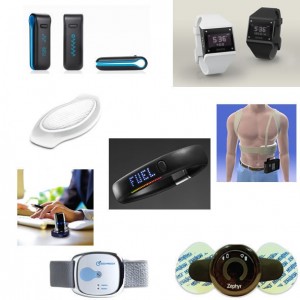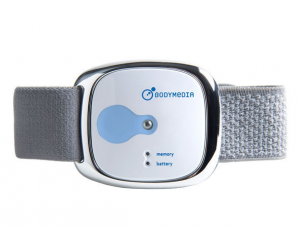Posted by Marianne Kolbasuk McGee 05/16/2012 InformationWeek/ Healthcare
Smartwatches may be cool, but wearable health monitoring devices could save your life. These gadgets now run the gamut in goals, from managing chronic disease to optimizing fitness programs.
Some devices allow medical providers to monitor a patient’s disorder, in the hopes that doctors can intervene earlier and patients can avoid complications. Other devices can detect whether an elderly patient has taken a fall, or remind patients it’s time to take their medications. Still other wearables allow consumers to keep tabs on their own health and fitness, helping them lose weight or sleep better. ABI Research last year estimated that the market for wearable health-related devices–ranging from heart monitors to biosensors that read body temperature and motion–will reach more than 100 million device sales annually by 2016. The market for wearable sports and fitness-related monitoring devices is growing, too, projected to reach 80 million device sales by 2016. Wearable devices provide output and connect to the Web in various ways. Some enable wearers to monitor their own readings using a mobile phone and a special website. Others allow data to be downloaded and viewed by third parties such as healthcare managers, or clinicians who are watching for disturbing trends that merit medical intervention. Some devices simply encourage wearers to share their fitness progress with work-out buddies and friends via social media sites. Thanks in part to trends such as wearable devices, the overall mobile health market is growing substantially. Research and analysis firm GlobalData expects the market to grow in value from an estimated $0.5 billion in 2010 to over $8 billion by 2018, significantly revolutionizing healthcare delivery and management. Take a look at the range of devices in use now, from hospital settings to homes.
IntelliVue MX40
Hospital patients often are tethered to various monitors, pumps, and medical gear. The IntelliVue MX40 from Philips Electronics tries to simplify some of that by putting Philips telemetry into a compact wearable patient monitor that can be used to monitor ambulatory patients and patients during transport.
The MX40 allows patients to walk around care settings and has a touchscreen display that lets clinicians see ECG, oxygen saturation (SpO2), and other vital signs in real time with just a push of a button. The device is also watertight to withstand patient showering, accidental immersion into water, and disinfectant cleaning. The device helps saves nurses’ time because it lets them check on patients’ ECG rhythms without making a call to technicians at central station monitors.
BlueLibris
Telehealth vendor Numera recently acquired BlueLibris, a maker of health monitoring devices. Its soon-to be-released wearable mobile device provides two-way, hands-free voice communication through a cellular network; GPS location tracking; and automated fall detection algorithms for Personal Emergency Response Services (PERS). Pictured here is the flagship BlueLibris device in a charging cradle.
Numera says BlueLibris devices also will be equipped with Numera’s telehealth gateway technology, allowing patients to upload biometric measurements from a variety of health devices through the mobile personal health gateway and receive personalized reminders to take medications, upload measurements, and receive coaching specific to health conditions. Numera plans to market the BlueLibris product through distribution and business partners by the fourth quarter of 2012.
BioHarness BT
Zephyr Technology’s BioHarness BT sensor technology is used by third-party makers of products to add biometric monitoring capabilities to wearable fitness gear. An example of that includes Under Armour’s E39 electronic compression garment, which tracks the wearer’s measures, including breathing and heart rate data, which can be transmitted to computers or mobile devices. Other measures BioHarness BT can monitor are blood oxygen, ECG, and blood pressure. The device also can connect to smart phones for transmission of the data to the Zephyr portal. From here, the data can be pushed to an individual’s personal electronic health records and dispatch and service center Web applications.
In April, 3M New Ventures, the venture organization of 3M, announced that it had invested in Zephyr Technology and was collaborating with the company for new physiological and biomechanical sensor and monitoring applications.
Body Motion Patch
BodyMedia and Avery Dennison Medical Solutions, a business unit of Avery Dennison Corporation, have developed a disposable body motion monitoring patch they say offers a comfortable, economical way to gather physiological data for health and wellness initiatives.
The patch combines Avery Dennison Medical Solutions’ proprietary MetriaTM Wearable Sensor Technology in a skin-friendly patch with BodyMedia’s proprietary algorithms and body monitoring expertise, which are used in BodyMedia’s previously announced armband monitoring product. The new wearable patch initially will be used as an evaluation tool for weight management and monitoring calorie burn, steps taken, activity levels, and sleep patterns through multiple sensors that collect more than 5,000 data points per minute, said BodyMedia. The patch allows that data to be uploaded to a computer or mobile device for use as a guideline to determine the need for weight loss and other wellness efforts. The patch, which is worn on the back of the left tricep, can remain in place for up to seven days, including while showering. Future applications are expected to include corporate wellness programs, remote elder care and safety, and monitoring of vital signs for a variety of health conditions. Expected to launch by the end of this year, the patch will use sensor technology similar to that developed for BodyMedia armband-based body monitoring systems that have been used for weight-loss support since 2001. The companies hope the patch’s smaller size, shorter- term use, and significantly lower price will help consumers to see the value of continuous body monitoring for weight management.
Zoll LifeVest
The Zoll LifeVest wearable defibrillator monitors heart patients at risk for sudden cardiac arrest. If a life-threatening heart rhythm is detected, the device delivers a shock to restore normal heart rhythm.
The LifeVest can be used for a wide range of patient conditions or situations, including following a heart attack, and before or after bypass surgery or stent placement. It’s also suitable for patients with cardiomyopathy or congestive heart failure. The vest also can be used as a temporary safeguard while a patient’s physician evaluates the individual’s long-term arrhythmic risk and treatment plans. Zoll says the LifeVest is lightweight and easy to wear, allowing patients to return to their activities of daily living at home, while having the peace of mind that they are protected from sudden cardiac arrest.
Basis B1
The consumer-oriented Basis B1 wrist band–expected to become available in 2012– incorporates five sensors to provide a precise view of a person’s health immediately and over extended periods of time. The device includes: an optical blood flow sensor that detects heart rate, through pulse or blood flow; a 3D accelerometer, a highly sensitive sensor that detects the smallest movements, regardless of whether users are alert and active or sleeping; a body temperature sensor to measure exertion during activity; an ambient temperature sensor to detect the outside temperature and compare it to body temperature to boost the accuracy of caloric burn calculations; and a galvanic skin response sensor to measure the intensity of sweat output.
Basis says the B1 multi-sensor band helps provide an “insightful picture of your health.” The band can link to the wearer’s personal Web dashboard so he can easily view performance, share data, and engage with other Basis B1 users.
FuelBand
Nike FuelBand, a fitness monitoring wristband, captures and displays four different metrics: time, calories, steps, and “NikeFuel,” a metric coined by Nike that measures the user’s physical activity. NikeFuel is a proprietary technology that measures activity through the movement of the user’s wrist and uses algorithms based on oxygen kinetics. Unlike calorie counts, which vary based on gender and body type, NikeFuel is “a normalized score that awards all participants equal scoring for the same activity regardless of their physical makeup,” said the company. Nike FuelBand users also can choose to also receive a calorie count to understand how many calories are burned versus how much NikeFuel is earned.
The wrist band can sync with Nike’s website through a built-in USB port, or wirelessly through Bluetooth to a free iPhone app to record the user’s activity each day and track progress. Fitbit Ultra
The tiny Fitbit Ultra tracks a user’s steps, distance, and sleep, as well as counting calories burned. Wireless uploads are automatically sent to user’s personal dashboard on Fitbit’s site, where free online tools show how the user’s physical activities add up. An iPhone app also lets users log workouts, diet, and food goals.
Fitbit Ultra not only holds an accelerometer but an altimeter that tracks the number of stairs or hills climbed each day. To keep you going, the tracker also displays motivational messages when you start moving.
BodyMedia Link Armband
BodyMedia’s Link Armband, a body-monitoring armband equipped with Bluetooth wireless technology, communicates directly with a smartphone app. The device provides real-time, up-to-the minute streams of information such as caloric burn data, physical activity level, and steps taken. The armband collects physiological data using four sensors that capture more than 5,000 data readings every minute. The raw data includes measurements of heat flux, skin temperature, motion, and galvanic skin response. BodyMedia says proprietary algorithms convert these readings to capture key parameters that directly affect people’s health and wellness: calorie burn, physical activity duration, steps taken, and sleep duration and efficiency.
BodyMedia also offers a subscription-based service called Activity Manager that lets users enter their own body parameters and goals for a running progress report. Goals can include steps taken, time spent in moderate and vigorous activity, nutritional analysis, and sleep efficiency.





